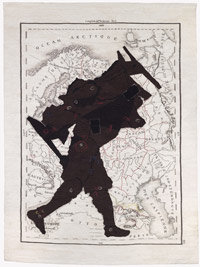Notations/William Kentridge
dal 11/12/2007 al 5/4/2008
Segnalato da
11/12/2007
Notations/William Kentridge
Philadelphia Museum of Art, Philadelphia
The tapestries stem from a series of drawings in which he conjured shadowy figures from ripped construction paper and collaged them onto the web-like background of nineteenth-century atlas maps. The hybrid figures that emerge in multiple mediums throughout the exhibition derive from Kentridge's longstanding interest in shadows and projections. On show also drawings, bronze sculptures, etchings, and an artist book.

Curated by Carlos Basualdo and Erica Battle
Incisively political and profoundly poetic, William Kentridge's protean artistic investigation continues in his beautiful series of tapestries begun in 2001. The tapestries stem from a series of drawings in which he conjured shadowy figures from ripped construction paper and collaged them onto the web-like background of nineteenth-century atlas maps. As the fourth and most ambitious installment of "Notations"—the Museum's ongoing series of installations that explore specific aspects of contemporary art—William Kentridge: Tapestries is the first exhibition of the artist's tapestries in the United States. The tapestries along with related works—drawings, bronze sculptures, etchings, and an artist book—will fill two galleries, plotting a course through the artistic context from which the tapestries originate.
The hybrid figures that emerge in multiple mediums throughout the exhibition derive from Kentridge's longstanding interest in shadows and projections. Collaged atop atlas pages in Kentridge's Puppet Drawings, marching across the accordion-style encyclopedia in his Portage book, and materializing into bronze sculptures, the figures—often burdened with the weight of objects and the world—become refugees, migrants, and movers of possessions. Silhouetted so that porter and parcel become one, Kentridge's processional characters evoke the political and cultural volatility that characterized recent South African history while also alluding to a global condition of transit and transition.
To reincarnate these figures into tapestry, Kentridge worked in close collaboration with the Johannesburg-based Stephens Tapestry Studio, mapping out cartoons from enlarged photographs of the drawings and hand-picking dyes to color the locally spun mohair. The tapestries' processional figures trek across mapped geography and into new artistic territory for Kentridge, but one in which the mechanism of drawing and the power of shadows remain central to his representations of a world in transition.
Support
Support for this exhibition is provided by the Philadelphia Exhibitions Initiative, a program of the Philadelphia Center for Arts and Heritage, funded by The Pew Charitable Trusts, and administered by The University of the Arts. Additional funding was provided by a generous gift from Dina and Jerry Wind.
Image:Porter Series-Man with Bed on Back, 2006, William Kentridge, Mohair, silk and embroidery 123 x 90, Private collection.
Philadelphia Museum of Art
Benjamin Franklin Parkway at 26th Street - Philadelphia



